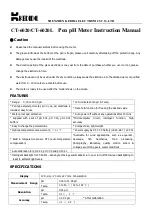
semi-permanent mounting, substitute epoxy or another
type of adhesive.
STEP 3:
Hand-tighten the sensor/mounting stud to the
machine, then secure the sensor with a torque wrench to
the mounting surface by applying the recommended
mounting torque. (See enclosed specification data sheet
for proper mounting torque.)
It is important to use a torque wrench during this step.
Under-torqueing the sensor may not adequately couple
the device; over-torqueing may result in stud failure and
possibly permanent damage.
4.2 ADHESIVE MOUNT
Adhesive mounting is often used for temporary
installation or when the machine surface cannot be
adequately prepared for stud mounting. Adhesives like
hot glue or wax work well for temporary mounts; two-part
epoxies and quick-bonding gels provide a more
permanent mount.
Note:
Adhesively-mounted sensors often exhibit a
reduction in high-frequency range. Generally, smooth
surfaces and stiff adhesives provide the best frequency
response. Contact the factory for recommended epoxies.
METHOD 1
–
Adhesive mounting base
This method involves attaching a base to the machine
surface, then securing the sensor to the base. This allows
for easy removal of the accelerometer.
STEP 1:
Prepare a smooth, flat mounting surface. A
minimum surface finish of 63 µin (0.0016 mm) generally
works best.
STEP 2:
Stud-mount the sensor to the appropriate
adhesive mounting base according to the guidelines set
forth in
STEPS 2
and
3
of the Stud Mount Procedure.
STEP 3:
Place a small portion of adhesive on the underside
of the mounting base. Firmly press down on the assembly
to displace any extra adhesive remaining under the base.
See Figure 7.
METHOD 2
–
Direct Adhesive Mount
For restrictions of space or for convenience, most sensors
(with the exception of integral stud models) can be
adhesive-mounted directly to the machine surface.
STEP 1:
Prepare a smooth, flat mounting surface. A
minimum surface finish of 63 µin (0.0016 mm) generally
works best.
STEP 2:
Place a small portion of adhesive on the
underside of the sensor. Firmly press down on the
top of the assembly to displace any adhesive. Be
aware that excessive amounts of adhesive can make
sensor removal difficult. See Figure 8.
4.3 MAGNETIC MOUNT
Magnetic mounting provides a convenient means for
making portable measurements and is commonly used
for machinery monitoring and other portable or trending
applications.
Note:
The correct magnet choice and an adequately
prepared mounting surface are critical for obtaining
reliable measurements, especially at high frequencies.
Poor installations can cause as much as a 50% drop in the
sensor frequency range.
Not every magnet is suitable for all applications. For
example, rare earth magnets are commonly used
because of their high strength. Flat magnets work well
on smooth, flat surfaces, while dual-rail magnets are
required for curved surfaces. In the case of non-magnetic
or rough surfaces, it is recommended that the user first
weld, epoxy, or otherwise adhere a steel mounting pad
to the test surface. This provides a smooth and
repeatable location for mounting.
STEP 1:
After choosing the correct magnet type,
inspect the unit, verifying that the mounting surfaces
are flat and smooth. See Figure 9.
Summary of Contents for IMI SENSORS 607A11/M015BZ
Page 17: ......






































